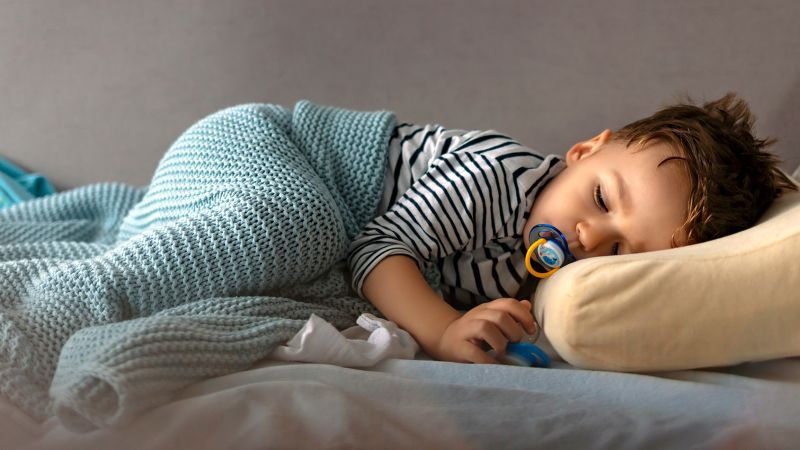Weaning Your Child Off A Pacifier Or Thumb: Age And Tips For Success

Welcome to your ultimate source for breaking news, trending updates, and in-depth stories from around the world. Whether it's politics, technology, entertainment, sports, or lifestyle, we bring you real-time updates that keep you informed and ahead of the curve.
Our team works tirelessly to ensure you never miss a moment. From the latest developments in global events to the most talked-about topics on social media, our news platform is designed to deliver accurate and timely information, all in one place.
Stay in the know and join thousands of readers who trust us for reliable, up-to-date content. Explore our expertly curated articles and dive deeper into the stories that matter to you. Visit Best Website now and be part of the conversation. Don't miss out on the headlines that shape our world!
Table of Contents
Weaning Your Child Off a Pacifier or Thumb: Age and Tips for Success
Saying goodbye to the pacifier or thumb can be a bittersweet moment for parents. While these comfort items have soothed your little one through countless sleepless nights and tantrums, the time comes when it's best to wean them off. But how do you do it successfully and without causing undue stress for your child? This guide provides age-appropriate advice and practical tips to help you navigate this transition smoothly.
The Ideal Age to Wean:
There's no magic age, but most experts recommend weaning your child off a pacifier or thumb between 12 and 36 months. Before 12 months, they rely heavily on these for comfort and self-soothing. After 3 years, the habit can become more ingrained and harder to break, potentially leading to dental issues. However, every child is different. Consider your child's developmental stage and readiness. Are they showing signs of independence? Are they able to communicate their needs more effectively? These are crucial indicators.
Potential Dental Problems:
Prolonged pacifier or thumb sucking can lead to several dental problems, including:
- Overbite: The upper jaw protrudes excessively over the lower jaw.
- Open bite: A gap between the upper and lower front teeth.
- Crossbite: The upper teeth bite inside the lower teeth.
- Malocclusion: Any misalignment of the teeth.
These issues may require orthodontic intervention later on. This is another reason to consider weaning before the age of 3.
Successful Weaning Strategies:
Weaning isn't a one-size-fits-all process. Experiment with different techniques to find what works best for your child:
1. Gradual Reduction:
- Reduce Usage: Start by limiting pacifier or thumb use to specific times, such as naptime or bedtime.
- Set a Schedule: Gradually decrease the time your child uses their pacifier or thumb each day.
- Reward System: Implement a reward chart to motivate your child and celebrate milestones. Small rewards, like stickers or extra playtime, can be highly effective.
2. The "Fairy/Tooth Fairy" Method:
- Create a Story: Involve a beloved character, like the Tooth Fairy or a special pacifier fairy, who will take the pacifier away in exchange for a small gift.
- Make it Special: This approach adds a magical element to the process, making it less traumatic for your child.
3. Cold Turkey:
This method works best for older toddlers who are more cognitively developed and understand the concept of giving something up. It's crucial to support them emotionally during this transition.
4. Distraction and Alternatives:
- Offer Alternatives: Provide alternative comfort objects, like a special blanket or stuffed animal.
- Distract with Activities: Engage your child in activities they enjoy to divert their attention.
5. Positive Reinforcement and Patience:
Remember, consistency is key. Be patient and supportive throughout the process. Celebrate small victories and avoid reverting to old habits. Positive reinforcement will encourage your child to continue their efforts.
Addressing Regression:
Regression is common. If your child relapses, don't get discouraged. Reiterate the plan and continue to offer support and encouragement. Sometimes a brief return to the pacifier or thumb is acceptable, but quickly redirect their attention towards the weaning plan.
When to Seek Professional Help:
If you're struggling to wean your child, or if they exhibit significant distress, consult your pediatrician or a child psychologist. They can offer guidance and support tailored to your child's specific needs.
Conclusion:
Weaning your child off a pacifier or thumb is a significant milestone. By implementing a gradual approach, utilizing positive reinforcement, and understanding your child's individual needs, you can make this transition a positive and successful experience for both you and your little one. Remember, patience and consistency are crucial. You've got this!

Thank you for visiting our website, your trusted source for the latest updates and in-depth coverage on Weaning Your Child Off A Pacifier Or Thumb: Age And Tips For Success. We're committed to keeping you informed with timely and accurate information to meet your curiosity and needs.
If you have any questions, suggestions, or feedback, we'd love to hear from you. Your insights are valuable to us and help us improve to serve you better. Feel free to reach out through our contact page.
Don't forget to bookmark our website and check back regularly for the latest headlines and trending topics. See you next time, and thank you for being part of our growing community!
Featured Posts
-
 Gary Lineker And The Bbc A Breaking Point Over Match Of The Day
May 20, 2025
Gary Lineker And The Bbc A Breaking Point Over Match Of The Day
May 20, 2025 -
 Masters Of Ceremony Warbond Pack Arrives In Helldivers 2 On May 15th
May 20, 2025
Masters Of Ceremony Warbond Pack Arrives In Helldivers 2 On May 15th
May 20, 2025 -
 Cannes Film Festival 2024 Kevin Spaceys Unexpected Award Acceptance
May 20, 2025
Cannes Film Festival 2024 Kevin Spaceys Unexpected Award Acceptance
May 20, 2025 -
 Data Breach At Legal Aid Thousands Of Criminal Records Potentially Stolen
May 20, 2025
Data Breach At Legal Aid Thousands Of Criminal Records Potentially Stolen
May 20, 2025 -
 Sundance Film Together Under Fire Copyright Infringement Suit Against Alison Brie And Dave Franco
May 20, 2025
Sundance Film Together Under Fire Copyright Infringement Suit Against Alison Brie And Dave Franco
May 20, 2025
Latest Posts
-
 Powerful Tornado Hits St Louis Assessing The Damage And The Path To Recovery
May 20, 2025
Powerful Tornado Hits St Louis Assessing The Damage And The Path To Recovery
May 20, 2025 -
 Lufthansa Flight Autopilot Engagement Following Co Pilots Fainting Spell
May 20, 2025
Lufthansa Flight Autopilot Engagement Following Co Pilots Fainting Spell
May 20, 2025 -
 Jamie Lee Curtis And Lindsay Lohans Honest Friendship A Rare Hollywood Bond
May 20, 2025
Jamie Lee Curtis And Lindsay Lohans Honest Friendship A Rare Hollywood Bond
May 20, 2025 -
 Family Struck By Train Two Dead Children Injured On Railroad Bridge
May 20, 2025
Family Struck By Train Two Dead Children Injured On Railroad Bridge
May 20, 2025 -
 Increased Consumer Safeguards Changes To Buy Now Pay Later Laws
May 20, 2025
Increased Consumer Safeguards Changes To Buy Now Pay Later Laws
May 20, 2025
